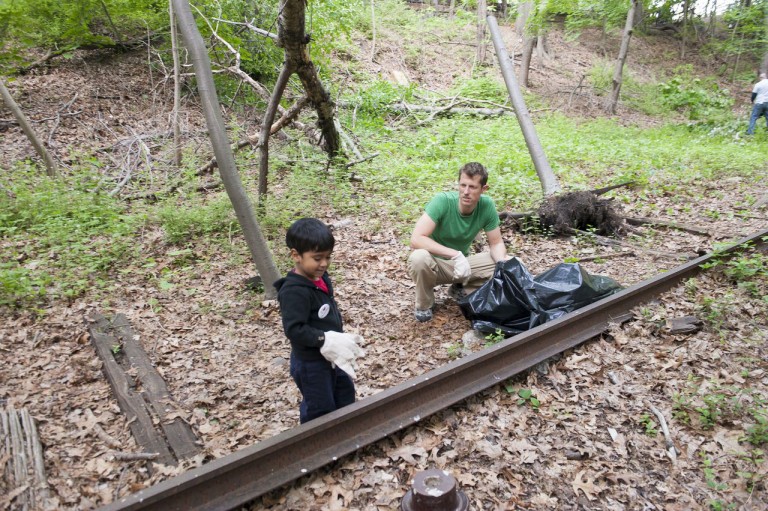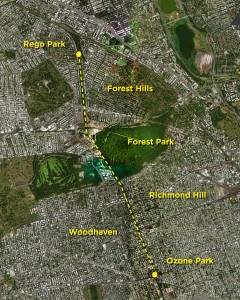Described by some as the “High Line” of Queens, the QueensWay project to transform 3.5 miles of abandoned borough rail track into city parkland has captured public imagination and attracted numerous design applications. According to the Trust for Public Land’s New York state director Marc Matsil, the TPL is choosing just one winner, to be announced this week.
Gov. Andrew Cuomo last year awarded a $467,000 grant to the Trust for Public Land for a safety and feasibility study of the former Rockaway Line – and the TPL issued a request for proposals that also sought potential designs.
After receiving 29 applications from firms all over the world, six finalists have been chosen. The winning firm will detail what it would take to transform the abandoned Long Island Railroad Rockaway railway line that connects Forest Hills, Rego Park, Woodhaven, Richmond Hill, and Ozone Park.
While some Queens residents oppose the project, fearing construction or disruption in their backyards, Matsil said many are supporters.
“This is basically a community amenity, and the most important cornerstone to public land is community engagement and we don’t build parks unless we’ve vetted,” he said.
The park would serve approximately 250,000 people who live in its surrounding area, help prevent traffic congestion, give bikers a safe place to ride and stressed that “Ozone Park has an absolute lack of parkland,” Matsil said.
The tracks are controlled by the city, with the exception of one mile of rail that passes through Forest Park. While the Metropolitan Transportation Authority or some other entity could try to obtain the tracks, Matsil explained it was unlikely, since the city would have to go through a process called “alienation,” wherein it would be forced to replace the mile-long stretch of city parkland with a parcel of an equal size. As most city dwellers know, a mile of parkland isn’t easy to find.
Created around the turn of the 20th century, the Rockaway Line closed in the 1960s, when the A train began to serve the Rocakways. The tracks have since fallen into disrepair, overgrown with weeds and suffering from structural damage in areas.
Matsil said an environmental study is expected to be completed within 10 months.
“We’re not anticipating finding anything horrible but you never know,” Matsil said. “The assumption is, these are structures that are built to hold trains, so bikes and people walking and running shouldn’t be a problem.”
There have been a number of studies examining reactivation for use by the MTA and the Port Authority of New York and New Jersey, however, according to the TPL, the studies concluded that rail reactivation was not feasible because of cost and environmental concerns and noted “significant community opposition.”
Assemblyman Phil Goldfeder (D-Rockaway Beach) and U.S. Reps. Gregory Meeks (D-Queens) and Hakeem Jeffries (D-Brooklyn and Queens) have thrown their support behind rail activation.
Goldfeder said restoring rail service could help the Rockaways recover economically from the aftermath of Hurricane Sandy.
“Restoration of the abandoned rail line as an efficient transportation alternative to the A Subway Line would be welcomed news to residents who currently suffer with commutes of well over an hour to midtown Manhattan,” Goldfeder said earlier this month.
Matsil said the rail failed due to lack of ridership, but Goldfeder believes that with a growing population in southern Queens and the Rockaways, and the opening of Resorts World Casino at Aqueduct Racetrack, restoration of the rail line is “needed now more than ever.”
Because the tracks run close to private residences in some places, park advocates argue more opposition to track-reactivation than to the QueensWay project can be expected.
In addition to “Friends of the QueensWay”– a group formed to support the park project, “No Way QueensWay” has also been founded. Neil Gianelli, the group’s leader, collected around 200 signatures from individuals on 98th Street in Woodhaven who object to the greenway and has argued property values would fall if the plan was implemented.
Andrea Crawford, second vice chairwoman of Community Board 9 and a member of Friends of the QueensWay, said the idea for the project germinated in 2004, when “there just really wasn’t an understanding of what it could be. Then the High Line hit and there was an understanding.”
The project is bringing positive attention to the borough, with editorials on the subject published recently in AM New York and the New York Times.
“People who knew nothing about Queens are learning about Queens,” Crawford said.
Friends of the QueensWay recently organized a cleanup of the tracks above Forest Park, indicative, advocates say, of the ways in which QueensWay could revitalize the downtrodden rail area.
“I think that [QueensWay] will show that we can do something really grand and really appropriate, and something that’s family friendly and that enriches the community that’s here,” Crawford said. “And I think this is something we can all get behind.”
By Elizabeth Daley


